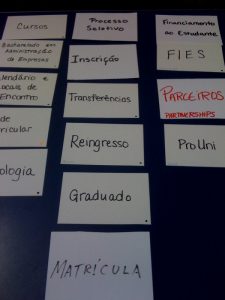enrollment
How to erase language barriers in Web discovery and development
I recently took some of my team members (Nathan Gerber and Mary Makowsky) with me to visit our client in Brazil. We are working with our content management system (CMS) partner, OmniUpdate, to redevelop the Web site for a campus in Brasilia and needed to facilitate some discovery research to support the project. We were planning to do four card-sorting exercises and two focus groups in addition to our stakeholder meetings with our campus colleagues.
I’m certain that you all know what I mean by focus groups, but “card sorting” may be a bit of a mystery so here’s a quick explanation:
Card sorting is a technique used to demonstrate how site users would like to see information organized on a Web page. It gives you a sense of their priorities, the names they use for resources and how they group like content. We created a deck of 5×7 index cards with the names of the current site links (in Portuguese) , added a few that we thought might be interesting and allowed the participants to create their own. You begin the group with an explanation of the task and then stand back, watch and listen. When they have completed their “page” you ask them to review each link, where they placed it and discuss any added links. It is also helpful to discuss the cards that they did NOT choose.
One final process note. We recommend having two people work on the card sort as a team. In the sessions with just one individual we noted many fewer cards used. The two groups we did with two individuals working as a team produced the most coherent results. Our group of four, also working as a team, resulted in some distracting debates among the participants.

A small challenge: No one on the NL team speaks Portuguese and few of the subjects spoke English.
The mitigating circumstance: Jorge, our translator.
We made sure that Jorge understood our goals, facilitation rules and process. He did a great job supporting the participants and our team and by the end of the sessions had some helpful reflections to add to our analysis.
What’s the big takeaway for me in this experience (and hopefully you, too)? Don’t be afraid to engage non-English speaking users in your Web discovery and user testing research. Most of the colleges and universities we serve up here in North America have increasing populations of Hispanic students or are working really hard to recruit specific international populations. The default Web resources offered by most schools for non-English content is typically just a few translated pages of text or a device like Google Translate.
What if we took a little more time to ask them what they want to see on your site in their native languages? How could this change their perception of your school and demonstrate your interest in welcoming them (or their children) to your campus?
With a little bit of planning and the right translator, this kind of exercise could mean a great step forward in your recruitment marketing efforts. And if you haven’t used card sorting at all in the regular assessment of your Web site, I hope you’ll give it a try.
A few final gastronomic notes regarding our experiences Brazil.
1. Eat the pizza. They put this special cheese called Catupiry in the crust and it is amazing.
2. Coffee comes with milk in the morning, but not in the afternoon. Drink it anyway–delicious!
3. Try the cashew (caju) juice.
Boa sorte!